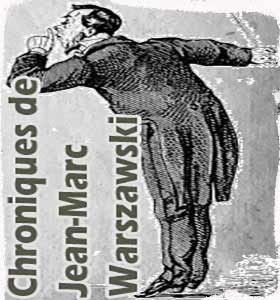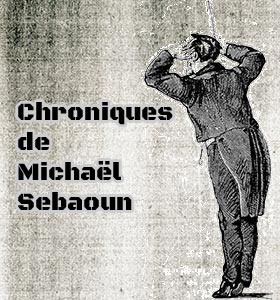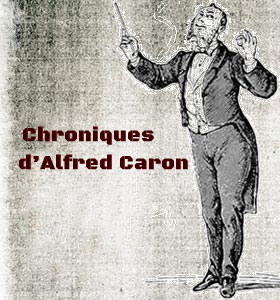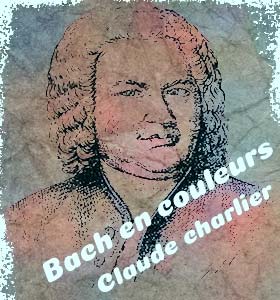Cette page est récupérée de la Toile : une adresse qui ne répond plus
Jay Hook ——
Claude Debussy : Annotated Bibliographies.
Brown, Matthew. "Tonality and Form in Debussy's Prélude à l'Après-midi d'un faune." Music Theory Spectrum 15 (1993), 127-143.
Heinrich Schenker would not have approved of the application of his analytical methods to the music of Debussy, for which he made no secret of his distaste. Many other analysts, too, noting that Debussy's genius lay in his rejection of traditional tonal practices, have assumed that Schenkerian analysis was of little use in explaining the subtleties of this music. Brown counters these claims with aplomb, giving a thoroughly convincing Schenkerian reading of L'Après-midi d'un faune.
Brown views the work as a continuous ternary form, whose outlines are obscured by a variety of devices: an incomplete progression of the form vii7/V-V9-I at the outset; a whole-tone episode that arises contrapuntally from complex passing motions in inner voices; development of distinctive melodic figures across formal boundaries; and the use of only a short segment of the opening section as the tonal model for the final section. These features, Brown points out, are unusual by traditional standards, and surely helped Debussy to move away from conventional symphonic models, but do not represent a complete repudiation of tonal paradigms.
The article ends with a brief description of Debussy's further developments of the same techniques in his later orchestral works, such as the Nocturnes, La Mer, and Ibéria.
(Jay Hook)
Davidian Teresa. "Intervallic Process and Autonomy in the First Movement of Debussy's Sonata for Cello and Piano." Theory and Practice 14/15 (1989/90), 1-12.
Drawing on earlier work by Robert Moevs ("Intervallic Procedures in Debussy: Serenade from the Sonata for Cello and Piano, 1915," Perspectives of New Music 8 [1969], pp. 82-101), Davidian maintains that intervallic procedures are important structural determinants in Debussy's Cello Sonata. "As tonality breaks down," she writes, "intervals play an increasingly central role, and ... the intervallic procedure is ultimately one that may contradict traditional tonal precepts."
Davidian discusses only the Sonata's first movement, which she views as a rather freely organized ternary form. The intervallic content, in her conception, is organized in a sort of arch design, in which the materials of the first part return, after the central climax, "in loose retrograde formation." Early in the piece the emphasis is on interval class 1; the interval of emphasis widens through ic2, ic3, and ic4 to ic5 at the point of climax (m. 29), before retreating to ic1 at the end of the movement.
As "the most vivid example" of her thesis, Davidian points to mm. 21-28, the passage leading to the climax in which ic3 gives way to ic4 and finally to ic5. It is undeniably true that there are many minor thirds in mm. 21-23 and many major thirds in mm. 24-28 (at least in the piano part--the cello repeats the same figure, which contains no major thirds, throughout these eight measures). In fact, the pitch material of mm. 21-23 is octatonic, and that of mm. 24-28 is constructed largely of augmented triads--two seemingly straightforward observations that Davidian curiously neglects to mention in several pages about the intervallic content of these measures. That this "vivid example" hardly generates an entire arch structure should go without saying, and the fact that the remainder of the arch is much more sketchily documented is, unfortunately, not the only troubling aspect of Davidian's analysis.
Consider the climax at m. 29. The harmony here is essentially pentatonic; the distinctive sonority comes not from the perfect fourths and fifths (ic5), as it would have to in order to support Davidian's contention, but from the major seconds. Moreover, the thematic material here reprises that at the beginning of the piece (where Davidian labeled it an "introduction" outside the compass of the arch). In fact, m. 29 is such a strong point of arrival that Davidian's entire formal analysis seems suspect. It was not on mere whim that Debussy called his three final compositions "Sonatas"; for the climax of a piece to occur at the beginning of the third and final subdivision of the central section of a ternary form, as Davidian claims, seems unlikely when it could be seen instead as the point of recapitulation in a creatively handled sonata form.
(Jay Hook)
Howat, Roy. Debussy in Proportion: A Musical Analysis. Cambridge: Cambridge University Press, 1983.
Proportions in close agreement with the Golden Section and the Fibonacci Series have been observed in the music of many composers. (See, for example, Ernö Lendvai, Béla Bartók: An Analysis of His Music [London: Kahn & Averill, 1971], pp. 17-34.) Howat presents a systematic study of such proportions in the music of Debussy.
Howat finds consistently applied proportional schemes in Debussy's music as early as the Ariettes oubliées of 1885-88 and Claire de lune of about 1890. He gives detailed analyses of L'isle joyeuse (1904) and "Reflets dans l'eau" (the first piece from Images, Book I, a set composed in 1905 in which Howat finds some of the clearest applications of the Golden Section). In Howat's most substantial analysis, he devotes four full chapters to La Mer (1905); he considers not only proportions within each of the work's three movements but also proportional structures linking the movements and unifying the work as a whole. There are also briefer analyses of several other works: "Mouvement" and "Hommage à Rameau" (also from Images, Book I), "Jardins sous la pluie" (from Estampes), D'un cahier d'esquisses, "Cloches à travers les feuilles" and "Poissons d'or" (from Images, Book II), and Prélude à l'Après-midi d'un faune.
Not content with identifying major climaxes at Golden Section points, Howat goes much further and presents complex proportional networks involving dynamic shape and appearances of motives and tonal areas. The text is supplemented with many musical examples and diagrams, often elaborate but always clear, with the aim not only of demonstrating the proportional structures but also of elucidating the many ways in which those structures contribute to the music's dramatic and expressive qualities.
Howat does not claim to provide a definitive answer to the question of whether or not the proportions he identifies are the result of a conscious design by Debussy. Indeed, there are a few cases in which the musical events connected in Howat's diagrams seem rather arbitrarily chosen, and one suspects that the proportional relationships may be little more than coincidence. Nevertheless, the sheer quantity of the relationships he presents is impressive, and often the proportional structures do correspond with a listener's intuitive sense of the dramatic ebb and flow of the music. Howat's work is noteworthy also in that it is one of the relatively few significant works of musical analysis in which pitch materials are often subordinate in importance to matters of tempo, rhythm, meter, and dynamics.
(Jay Hook)
Lewin, David. "A Transformational Basis for Form and Prolongation in Debussy's 'Feux d'artifice,'" in Musical Form and Transformation: Four Analytic Essays. New Haven: Yale University Press, 1993, pp. 97-159.
In the last and longest of the four essays in this volume, Lewin turns to the last and longest of Debussy's twelve Preludes for piano, Book II. In a rigorous, no-nonsense style, he applies concepts of set theory to explain the sometimes rather elusive compositional logic of "Feux d'artifice."
Taking last things first, Lewin begins with the famous Marseillaise quotation at the end of the piece. Many have found this moment puzzling, as the anthem is quoted in two fragments, pianissimo, a few measures after a cataclysmic climax ("climactic bomb" in Lewin's words). It is Lewin's contention, however, that Debussy's placement of the quotation is correct and logical, and he proceeds to show that the Marseillaise fragments represent the culmination of a number of musical processes that have been at work throughout the Prelude.
Lewin divides "Feux d'artifice" into a number of episodes, each with its own internal logic but with more broadly scaled procedures unifying the entire piece. In one section, for instance, he discerns a miniature theme with variations; the theme consists, in effect, of two voices, of which one moves upward by T4 from variation to variation, the other by T5. Lewin remarks that much of the material of the piece divides clearly into "white-note material" and "black-note material"- an observation interestingly reminiscent of Cone's idea of "stratification" in the music of Stravinsky and that the two are frequently related by the transformation T1.
Every assertion Lewin makes about sets and transformations is accompanied by a meticulous mathematical proof. Although maintaining such a standard is admirable, many readers may wish that Lewin had sacrificed a bit of mathematical rigor in order to make his points about a 98-measure composition in something less than 63 pages.
(Jay Hook)
Parks, Richard S. "Tonal Analogues as Atonal Resources and Their Relation to Form in Debussy's Chromatic Etude." Journal of Music Theory 29 (1985), 33-60.
Tonal resources are of course prominent in Debussy's music, but he also frequently deploys pitch materials in contexts free ofall traditional tonal associations. In his book The Music of Claude Debussy (New Haven: Yale University Press, 1989), Parks discusses aspects of tonality and atonality at some length, giving many examples drawn widely from Debussy's output. In an earlier article ("Pitch Organization in Debussy: Unordered Sets in 'Brouillards,'" Music Theory Spectrum 2 [1980], pp. 119-134), he argued that a limited, well-defined group of pitch resources forms the basis of Debussy's Prelude "Brouillards" and provides coherence for its complex and varied musical surface. In the present article, which he describes as complementary to the "Brouillards" analysis, he turns his attention to "Pour les degrés chromatiques," the seventh of Debussy's Twelve Etudes for Piano, written in 1915.
Parks considers questions of tonality and atonality primarily on a local level, deliberately avoiding, for instance, announcing to the reader whether he considers the Etude as a whole to be a tonal or atonal composition. To facilitate his discussion, he introduces the concept of a "tonal analogue," defined as "a pitch combination in an atonal context that is familiar from its frequent and conspicuous occurrence in tonal contexts" (p. 35). Examples of tonal analogues include common triads and seventh chords, segments of diatonic scales, and some simple chromatic figures spanning diatonic intervals. Parks maintains that the primary pitch resources of the Chromatic Etude are a small number of tonal analogues introduced within the first ten measures.
Parks's analysis here is clearly in the same spirit as that in his book. Despite the ever-present trappings of tonality in the musical elements themselves, he uses set-theoretic notation and concepts to discuss them; one of the tonal analogues he distinguishes in the Etude, for example, is the major-minor seventh chord, which is considered equivalent to its set-theoretic inversion, the half-diminished seventh chord (set class 4-27), the traditional tonal distinctions between the two notwithstanding. Subset, superset, and complement relations figure prominently throughout, as do the four standard set "genera" (though he does not use that term here)- diatonic, chromatic, octatonic, and whole-tone. Parks gives many examples to show how manipulations of the primary pitch materials engender the various musical events of the Etude and unify the work; the overriding message seems to be that although the manipulations are those more often associated with atonal contexts, much of the individuality of Debussy's music stems from the favored status that he accords to tonal analogues in the selection of his basic materials.
(Jay Hook)
Trezise, Simon. Debussy: La Mer. Cambridge: Cambridge University Press, 1994.
One in a series of Cambridge Music Handbooks dealing with significant works from Bach to Stravinsky, this book of barely 100 pages offers an overview of La Mer, Debussy's symphonic masterwork of 1905.
The opening chapters describe the work's origins, its early performance history, and, in general terms, its musical style. Trezise recounts the sometimes scandalous upheavals in Debussy's personal life at the time he was composing La Mer, and the many difficulties encountered at the first performance (to which critical reaction was largely unfavorable). Valuable features of this part of the book include a survey of the changes Debussy made to the score in preparation for the publication of a revised edition in 1909 (most controversially, the omission of a series of brass fanfares from the last movement, often reinstated by conductors today); a comparison of Debussy's metronome markings with the tempos of several well-known recorded performances; and a fascinating glimpse of two earlier French symphonic suites titled La Mer, both apparently well-known in their day and undoubtedly familiar to Debussy but completely forgotten today: one by Victorin de Joncières (1881), and another by Paul Gilson (1892). There is also some discussion about the sources of La Mer's musical style (Trezise finds the influence of Wagner, Franck, and Rimsky-Korsakov), about Debussy's own views on programmatic music and depictions of nature, and about the merits of the term "impressionism."
Trezise's analysis of the work occupies roughly the second half of the book, beginning with a chapter on Debussy's formal designs and continuing with a discussion of rhythm, motive, and harmony. In many ways, these analytical chapters are less rewarding than the opening historical material. Trezise acknowledges in his Preface that Howat's proportional analysis based on the Golden Section and Parks's set-theoretic approach hold little interest for him. Debussy's formal structures are notoriously difficult to schematize, and Trezise's descriptive and rather simplistic labels such as "first principal section" and "interlude with chorale" are ultimately much less revealing than the intricate interrelationships perceived by Howat. In his discussion of harmony and tonality, Trezise occasionally makes interesting generalizations for instance, that Debussy often uses a tritone-related harmony functioning as a dominant but does not present sufficient details or examples to support them convincingly. Some of the comments about rhythm and phrase structure, on the other hand, offer valuable insights, and Trezise is surely in accord with Howat when he observes (p. 76) that "the shaping of time in La Mer has as much control over the structure as harmonic or motivic development."
(Jay Hook)
Wenk, Arthur B. "Parsing Debussy: Proposal for a Grammar of His Melodic Practice." In Theory Only 9 (May 1987), 5-19.
Several investigators have attempted to give systematic descriptions of musical intuitions using the principles of linguistics and cognitive science, notably Fred Lerdahl and Ray Jackendoff in A Generative Theory of Tonal Music (Cambridge: MIT Press, 1983). As Noam Chomsky was the first to point out, we all know much more about language than we are able to articulate; those who propose formal descriptions of musical styles maintain that it should be possible to codify exactly what accounts for our ability to recognize a piece in a certain style when we hear it. In this article, Wenk presents the initial steps toward a generative grammar of Debussy's melodic practice.
Wenk is no stranger to Debussy's music, having published several years earlier the book Claude Debussy and Twentieth-Century Music (Boston: Twayne Publishers, 1983), which gives an overview of much of the composer's music with a decidedly analytical slant. As the raw data for his grammar, he has selected 92 "initial melodic units" (he finds traditional terms such as "motive," "phrase," and "period" inappropriate) from Debussy's instrumental compositions. The grammar itself is based on one proposed by Baroni and Jacobini for Bach chorale melodies (see Mario Baroni and Carlo Jacobini, "Analysis and Generation of Bach's Choral Melodies," in Gino Stefani, ed., Proceedings of the First International Congress on Semiotics of Music, Belgrade, 1973 [Pesaro: Centro di Iniziative Culturale, 1973], pp. 125-134). The generative process begins with a "kernel interval" which is then elaborated through repetitions, neighbor tones, and various other procedures, culminating in the complete melody. Wenk introduces several modifications in the Baroni-Jacobini paradigm to account for Debussy's fondness for pentatonic melodies and melodies that oscillate or double back on themselves in certain characteristic ways.
The grammar Wenk constructs is capable of successfully generating all 92 of the chosen Debussy melodies. A grammar that generates too large a language, however, is just as inappropriate as one whose language is too restricted. Wenk gives examples of melodies by Berlioz and Wagner that cannot be generated by his grammar; he acknowledges, however, that additional contextual restrictions are necessary if certain other intuitively "un-Debussyan" melodies- such as the C major pentatonic theme from Beethoven's Leonore Overtures, or the opening bassoon solo from The Rite of Spring- are to be excluded. The article is a brief one, and the author admits that the work is incomplete; further work along the lines of this article could be valuable and illuminating.
(Jay Hook)
© Musicologie.org




 À propos - contact |
S'abonner au bulletin
| Biographies de musiciens | Encyclopédie musicale | Articles et études | La petite bibliothèque | Analyses musicales | Nouveaux livres | Nouveaux disques | Agenda | Petites annonces | Téléchargements | Presse internationale | Colloques & conférences | Collaborations éditoriales | Soutenir musicologie.org.
À propos - contact |
S'abonner au bulletin
| Biographies de musiciens | Encyclopédie musicale | Articles et études | La petite bibliothèque | Analyses musicales | Nouveaux livres | Nouveaux disques | Agenda | Petites annonces | Téléchargements | Presse internationale | Colloques & conférences | Collaborations éditoriales | Soutenir musicologie.org.
Musicologie.org,56 rue de la Fédération, 93100 Montreuil. ☎ 06 06 61 73 41.
ISSN 2269-9910.
Lundi 24 Novembre, 2025


